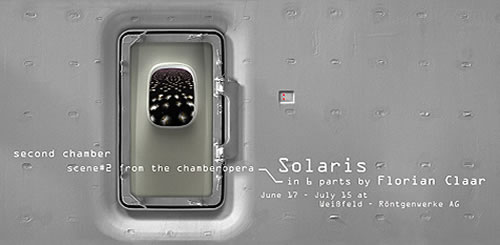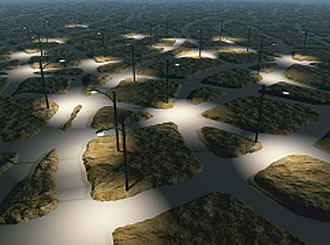
 |
|||||||
六本木のヴァイス フェルトでフロリアン・クラールによる「ソラリス:セカンド・チャンバー」が開催されました。 |
|||
 |
|||
artists statement スタニスワフ・レムは、その小説の中で、ソラリスのことを、孤立した、到達することのできない、そしてまた自然の法則の通 用しない惑星だと 述べている。 惑星ソラリスは、巨大な脳みそのような、思考する有機体の海で覆われている。そして、その軌道上にいるすべてのものーつま り惑星ソラリスの軌道を回る 宇宙ステーション「プロメテウス」に滞在する科学者たちーの記憶をスキャンし、それを彼らの想像に基づいて形 成した実体として彼らの目の前に派遣する。 この現実は変化し続けるものであり、『物質的な』現実と、彼らのために創造された『非物質的な 』ものの間では常に対話が交わされる。この、生命を持った 海の謎を解こうと、科学者たちは自身の心と記憶の奥深くへと入り込んでいき、 彼らの心の中と、彼らを取り巻く世界への理解を深めて行く。 スタニスワフ・レムはいつも私の想像力を刺激してきた。彼の本のほとんどにおいて、まったく非論理的な出来事が、最大限の論理を用いて 展開される。 レムが「ソラリス」で描いた場所は、そこで巻き起こる事象と心象の間の強力な相互作用、そしてこの現象を理解するために体 験しなくてはならない裏側の 理論など、まさに私の「チャンバー・オペラ」にとって最適に思えた。 私はこの本を開始点として、物語の中に出て 来る特定の要素を用いるのではなく、ソラリスで起こる現実に私自身の心を据えて何が起こるか見守りながら、 ゆるやかに素材に取り組み 始めてみた。そのことによって、より可能性が広がり、これまで私が魅了されたり強く影響を受けてきた他の世界のことも一緒に 作品の中に 取り込むことができた。何年もの間、私は舞台や映画、文学以外の場で物語を語る色々な方法を試みて来た。インスタレーションは、私にと って 鑑賞者の様々な感受性を取り込んで、幻想ではない実際の経験を作り出すことによってつながりのない物語を語ることのできる手段で ある。 今回の展示は、2001年に福岡の三菱地所アルティアムで発表した、以前のバージョンのソラリスの2番目のチャンバー(部屋)をリメイクしたも のである。 2番目のチャンバーは、空っぽの飛行機のような空間を縦横に覆う迷路のような構造を持つ。 2001年の三菱地所アルティアムで の展示では、私は6つの異なるチャンバーを制作した。その中心となるチャンバー・オペラは、中性的な空間を内側と外側 とに隔てる膜として 機能するソラリス・ステーションである。その内部には、場所と道、物質、音、声、音楽があり、絶え間ない変化が起こっている。 変化は、この 作品のもっとも重要な要素である。なぜなら、変化こそが真実の物語を語るからだ。これらの変化は、鑑賞者の記憶と相互作用を起こし、 フ レキシブルでつながりのない、夢の中のような状況の中で生まれる思考のような物語を作り出すもととなるのだ。 フロリアン・クラール |
|||
 Florian CLAAR -Solaris Chamber #2- |
|
||||||